
Olli Ilmari Rehn is a Finnish public official who has been serving as governor of the Bank of Finland since 2018. A member of the Centre Party, he previously served as the European Commissioner for Enlargement from 2004 to 2010, European Commissioner for Economic and Monetary Affairs and the Euro from 2010 to 2014, and Minister of Economic Affairs in Juha Sipilä's cabinet from 2015 until 2016. Rehn ran for President of Finland as an independent candidate in 2024, but was not elected.

The grasshopper subfamily Acridinae, sometimes called silent slant-faced grasshoppers, belong of the large family Acrididae in the Orthoptera: Caelifera.

Couroupita guianensis, known by a variety of common names including cannonball tree, is a deciduous tree in the flowering plant family Lecythidaceae. It is native to the tropical forests of Central and South America, and it is cultivated in many other tropical areas throughout the world because of its fragrant flowers and large fruits, which are brownish grey. There are potential medicinal uses for many parts of Couroupita guianensis, and the tree has cultural and religious significance in South and Southeast Asia. In Sri Lanka and India, the cannonball tree has been widely misidentified as the Sal tree, after its introduction to the island by the British in 1881, and has been included as a common item in Buddhist temples as a result.

The Melanoplinae are a subfamily of grasshoppers in the family Acrididae. They are distributed across the Holarctic and Neotropical realms. They are one of the two largest subfamilies in the Acrididae. As of 2001 the Melanoplinae contained over 800 species in over 100 genera, with more species being described continuously.

The family Phylliidae contains the extant true leaf insects or walking leaves, which include some of the most remarkably camouflaged leaf mimics (mimesis) in the entire animal kingdom. They occur from South Asia through Southeast Asia to Australia. Earlier sources treat Phylliidae as a much larger taxon, containing genera in what are presently considered to be several different families.
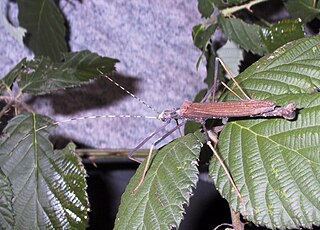
Pseudophasmatidae is a family of stick insect, in the suborder Verophasmatodea, commonly called the "striped walkingsticks". An important identifying characteristic is its mesothorax, which is never more than three times as long as the prothorax.

The Phaneropterinae, the sickle-bearing bush crickets or leaf katydids, are a subfamily of insects within the family Tettigoniidae. Nearly 2,060 species in 85 genera throughout the world are known. They are also known as false katydids or round-headed katydids.
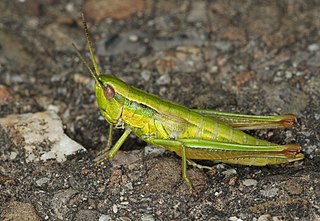
Gomphocerinae, sometimes called "slant-faced grasshoppers", are a subfamily of grasshoppers found on every continent but Antarctica and Australia.
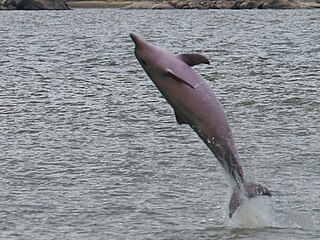
The dolphin genus Sotalia is considered to have two member species with the classification of Sotalia guianensis as a distinct species from Sotalia fluviatilis in 2007. This was a result of recent morphometric analyses, as well as mitochondrial DNA analysis.

Discophora is a genus of trees in the family Stemonuraceae. There are two species, Discophora guianensis and Discophora montana. The plants occur in the Neotropics.
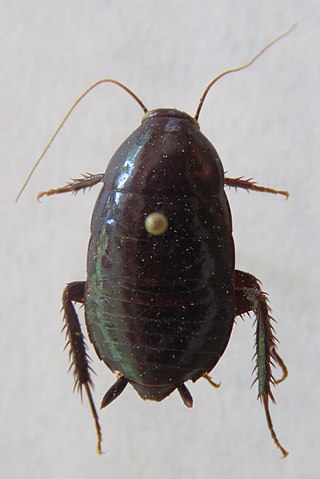
Lamproblattidae is a small family of South and Central American cockroaches in the order Blattodea. It consists of three genera and 10 species:

Acrididea including the Acridomorpha is an infraorder of insects that describe the grasshoppers and ground-hoppers. It contains a large majority of species in the suborder Caelifera and the taxon Acridomorpha may also be used, which excludes the Tetrigoidea. Both names are derived from older texts, such as Imms, which placed the "short-horned grasshoppers" and locusts at the family level (Acrididae). The study of grasshopper species is called acridology.

Conocephalinae, meaning "conical head", is an Orthopteran subfamily in the family Tettigoniidae.

The Tanaoceridae are an insect family in the monotypic superfamily Tanaoceroidea in the suborder Caelifera. They are sometimes called desert long-horned grasshoppers.
The Tristiridae are a family of grasshoppers, in the Orthoptera: suborder Caelifera. Species in this family can be found in the Americas.

The Hemiacridinae are a subfamily of Acrididae in the Orthoptera: Caelifera. Species can be found in Africa and Asia.

Circotettix is a genus of band-winged grasshoppers in the family Acrididae. There are about 9 described species in Circotettix.

The Heteropterygidae is a family of stick insects belonging to the suborder Euphasmatodea. Species can be found in Australasia, East and Southeast Asia. About 150 valid species have been described.
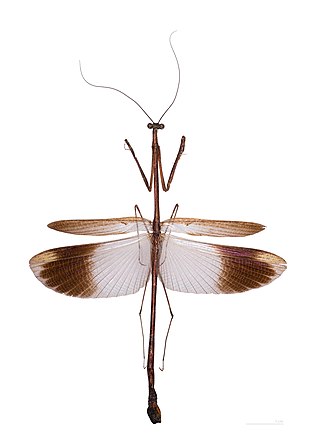
Angelidae is a family of mantises found in tropical Central and South Americas.
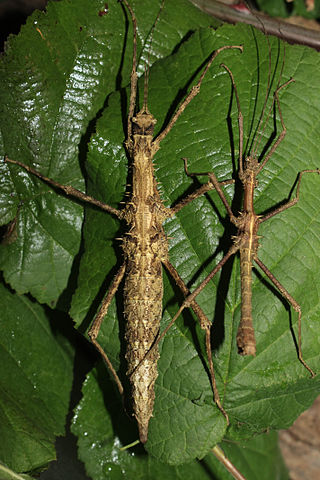
Obrimus is a stick insect genus native to the Philippines. It is type genus for the tribe and the subfamily in which it is listed.



















